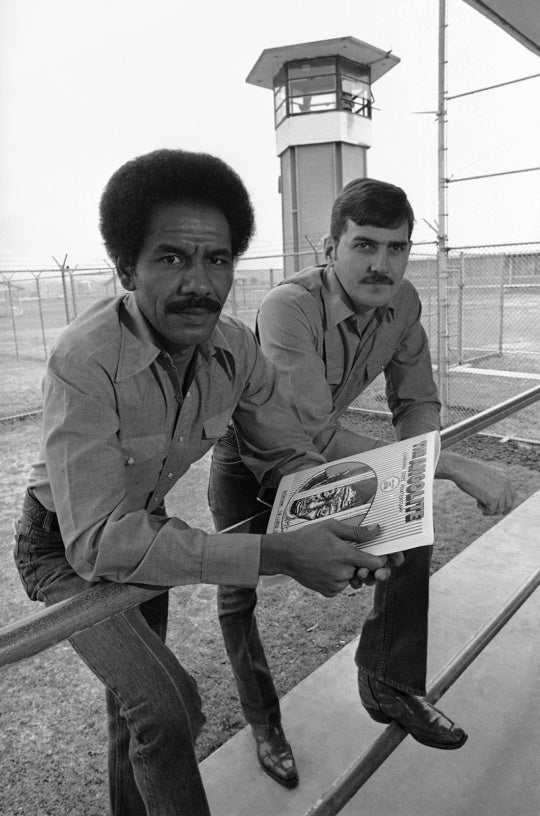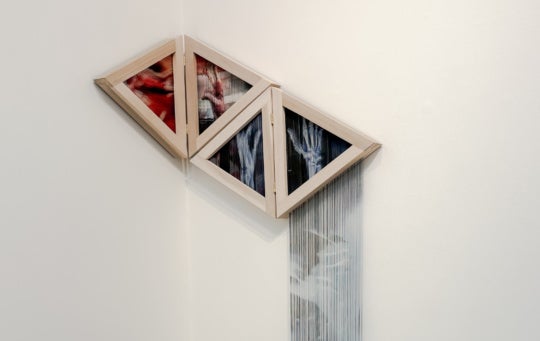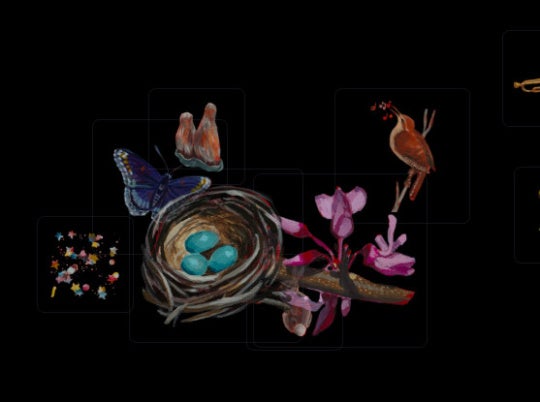 When it comes to following her creative instincts, Caroline Allison is one of those daring individuals who fulfills the idiom “seek forgiveness, not permission.” In fact, considering the impressive outcomes of her past harrowing feats (many of which include showing up for work alone and unannounced to smoky, ill-attended masonic lodges and VFW posts in the rural South), I presume that forgiveness, too, is foregone. While Allison’s adventurous work ethic conjures a righteous panic in some of us more cautious Janes, it also indicates the remarkableness of an artist and has served her well in 15-plus years of fine art and editorial photography.
When it comes to following her creative instincts, Caroline Allison is one of those daring individuals who fulfills the idiom “seek forgiveness, not permission.” In fact, considering the impressive outcomes of her past harrowing feats (many of which include showing up for work alone and unannounced to smoky, ill-attended masonic lodges and VFW posts in the rural South), I presume that forgiveness, too, is foregone. While Allison’s adventurous work ethic conjures a righteous panic in some of us more cautious Janes, it also indicates the remarkableness of an artist and has served her well in 15-plus years of fine art and editorial photography.
Lately, Allison has taken an unconventionally slow and steady approach to art-making in the midst of a high-output visual arts culture. She has long savored the technical process of developing shots from her large-format camera, as opposed to shooting digitally, and her workflow has organically followed suit. But it’s different now. In the past five years, Allison has started a family, to which she optimistically attributes the privilege of “taking the long view”—thinking in years not months—as she further examines this mysterious new work-life balance thing.
I recently met with Allison in her studio, which is a narrow but long, window-encased space on the backside of her beautifully restored, century-old home. The green foliage in the backyard belies the urban streetscape just yards away in one of Nashville’s hippest neighborhoods. “Coffee or wine?” she warmly greeted me at 6pm on a weeknight. (We speak the same language after a long day at the office.) Speaking of her “office,” Allison says she had previously rented a more formal studio space down the street from her home, but when circumstances changed she felt a need to have a smaller footprint between everyday responsibilities. From this home base, she keeps the wheels turning on the bus of life. Lined with bookshelves and an assortment of seating options (a nod to Allison’s social ease and hospitality of light company), her studio’s highlights were the prints hanging in rows on the walls and the handwritten notes—captured in moments of genius no doubt—scribbled on napkins, her father’s old letterhead, maps, ruled notebook paper, and other remnants of the recent past tacked onto a cork board.
Allison is poised and lovely. Her first solo exhibition since 2013 is scheduled for November 2016 at Zeitgeist Gallery. It will resume a familiar theme of juxtaposed familiarity and unexpectedness from her A Common Place and Interior Dialogues series but exude somewhat of a darker, more haunting tone than previous works. During a season charged with artistic experimentation and prolificacy, Allison reflects on her career and anticipates a full year ahead.

Elaine Slayton Akin: You have become well-known for your ritualistic process for photo-taking. Where did this originate, and why has it stuck with you for so long?
Caroline Allison: I like being slow in a space. I always have. Right out of [the Art Institute of Chicago], I tried the whole moving object, pseudo street style in black-and-white medium format, but I never felt totally comfortable. Today, I use a large-format camera with a two-minute exposure. I prefer still objects, and I deliberately take my time.
ESA: Your established series draw much of their character from historical sites. Why?
CA: I look for places that make you think something has occurred here. I know that sounds silly, because that’s technically true of everywhere. But sometimes I see an interior or landscape as the physical container of a past moment in time. I am also drawn to town names. I once visited Defeated, Tennessee, on a whim after randomly spotting it on a map. When I didn’t find what I was looking for, I ended up in Difficult—yes, that’s a town name, too—just a few miles down the road. It was the site of a Civil War encampment. It’s funny … I didn’t even know it was a historical site until after I had taken the shot.
ESA: Is there something specific about your childhood that kept drawing you, while living in Chicago for grad school and New York soon thereafter, back to the South to find creative inspiration (that is, assuming you consider yourself a Southerner)?
CA: Ha—yes, I’m from Atlanta. I’m a Southerner. While I can’t always put my finger on it, my professors certainly could. You know, when you’re in grad school, you’re critiqued by a panel of instructors … some know you, some don’t. It never failed: my Southernness became the conversation by the end of it all, even for instructors who had no idea where I was from. [Presumably because many of her photographs invoke a spirit of bygone times—an affecting stagnation more reminiscent of Elvis Presley’s beloved Graceland than, say, the Kennedy Compound in Hyannis Port (I’m thinking of Allison’s Twitty City photograph here)—and at the same time breathe new life into the visual history of Southern places by recirculating their images through a 21st-century perspective.]

ESA: As a more mature photographer now, what keeps you here?
CA: I have a real familiarity with the language here — comes with years of practice. I understand the culture and, whether it’s fair or not, the traditional roles of men and women in the South. For example, the gatekeepers for a lot of the rural places I want to photograph, like VFWs, are men. I need permission to shoot, and they are usually more than obliging to a “Southern belle.” I once gained access to a masonic lodge in Greenwood, Mississippi, while it was the set for The Help movie. I ate my lunch across from Allison Janney on break.
ESA: So what’s new with you?
CA: I’m preparing new work for my upcoming Zeitgeist show. I’m still seeking the same “something happened here” feeling. There will be more interiors and landscapes. But what’s coming this fall will be, in a way, the B-side … what’s been swept under and subdued … a continuation of American mythology through the transitional lens I learned in Interiors.
ESA: How are you preparing?
CA: Obsessive note-taking [she says with a laugh and points to the nearby cork board in her studio]. I jot notes down when I think of ideas, on napkins, scrap paper…whatever’s handy. I have a laundry list of interesting places I want to visit this spring and summer. They all have a common theme of historical significance, although that significance is not always overt. It’s like Money, Mississippi — again, the town name — where I photographed the dilapidated Meat Market where Emmett Till whistled at Carolyn Bryant back in the ’50s. It’s so cliché, but this market is a totem for that moment … for his death and for civil rights. And you’d never know where you’re standing unless you Googled it.

ESA: Does your Money experience set the tone for the Zeitgeist show?
CA: I do still wonder, what does it feel or look like to be such a major component of recent history? There is more to be discovered for sure … survivors … a rise or fall from grace. I’ll be expanding the narrative from previous bodies of work—more spaces and landscapes.
ESA: Your more circulated works do not contain the human figure. Why is that?
CA: I see landscapes as operating in the same way as portraits — all containers for moments — and portraits as operating like landscapes — less about a person and more of an encapsulation of history. I have never felt comfortable to presume that I can capture someone’s essence or soul. I don’t believe in the mystic power of the camera. I try to be as neutral as possible … an objective recorder. Portraiture can be abusive today. Who gets a say in what they want? Too beautiful is when there’s no tension between the artist and sitter. There are portraits that I adore, especially the work of Katy Grannan, Taryn Simon, Alec Soth. I’m hoping to incorporate more of their style into the Zeitgeist show.

ESA: Women sometimes get flack within the art community for pausing the creative process to be a caregiver. How has being a woman and a mother affected your career?
CA: Conversation on this is so welcome. I often get asked, “Still making work?” It’s true that I’m not as visible in the past couple of years. And I’m at a slower pace, gradually working my way back up to speed. I am learning patience and stamina … to be kind to myself. It’s a balancing act. Being a mom has allowed me to be more selective about what I present. I’m looking down the road in years instead of months.
ESA: How do you think Nashville’s “it city” rapid growth is impacting its creative economy?
CA: The fact that buildings are popping up all around us is ironic, because I photograph things disappearing. The growth is exciting, but I have some trepidation after experiencing the Atlanta boom firsthand. A city is at risk to lose some of its soul. I think timing is in Nashville’s favor though. People want to move toward the city center now, not so much the suburbs. My questions are: Are more people coming through the galleries? Are more people buying?
Elaine Slayton Akin is an arts writer and nonprofit professional in Nashville by way of Little Rock. She works at the Frist Center for the Visual Arts and is a member of the Inter-Museum Council of Nashville. Her writing has been featured in Nashville Arts, Arkansas Life, Number, and At Home in Arkansas magazines.




